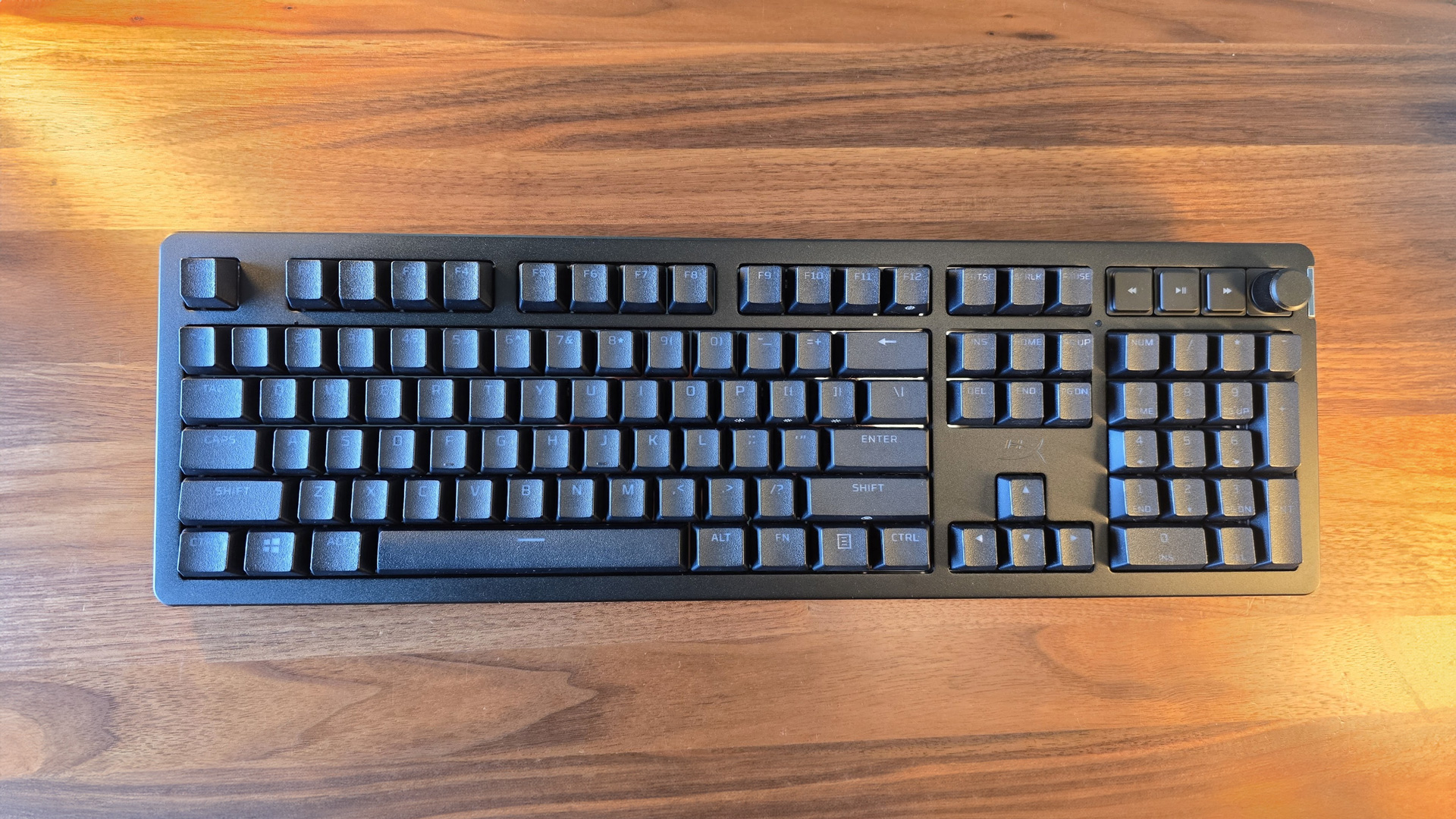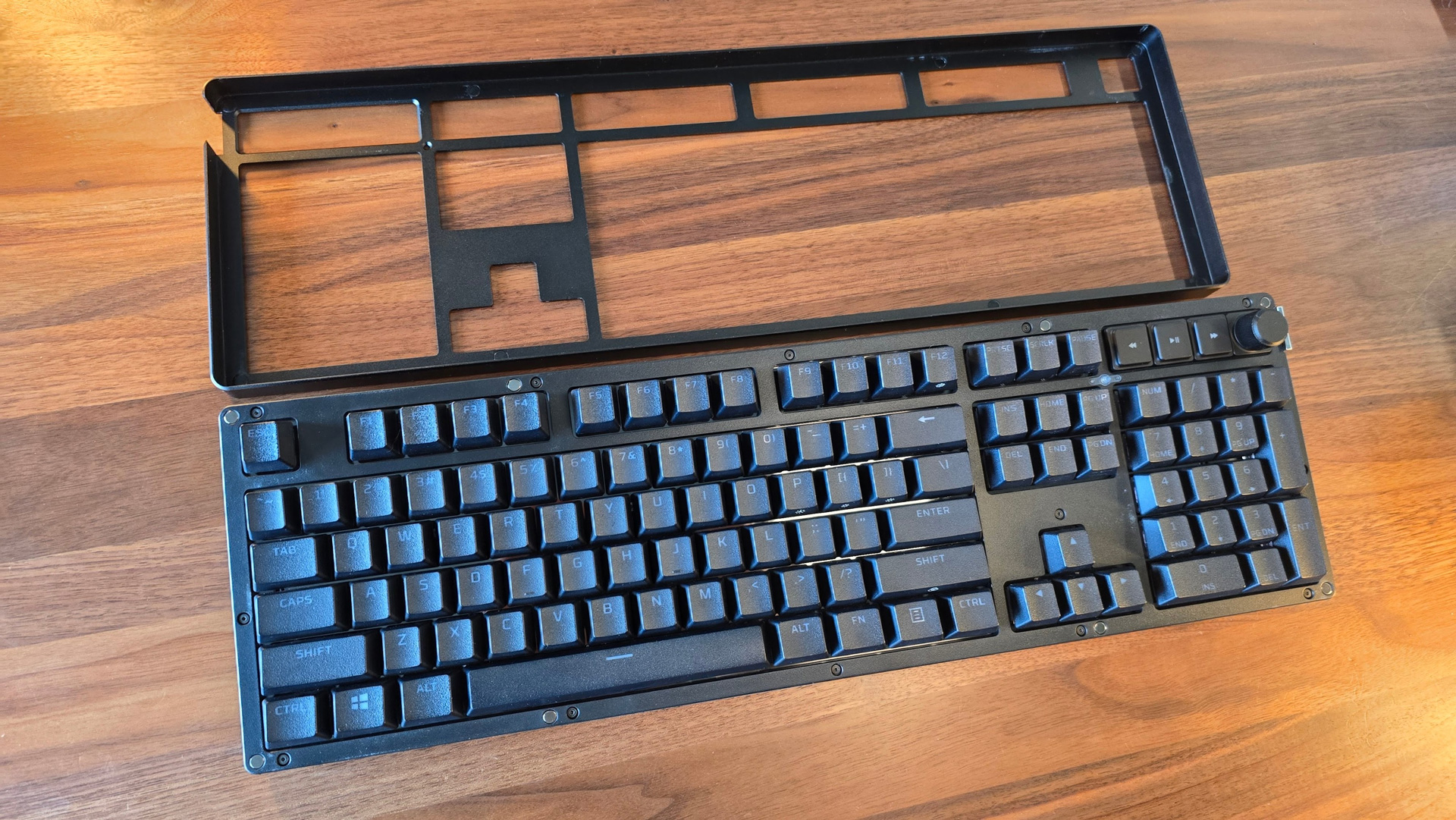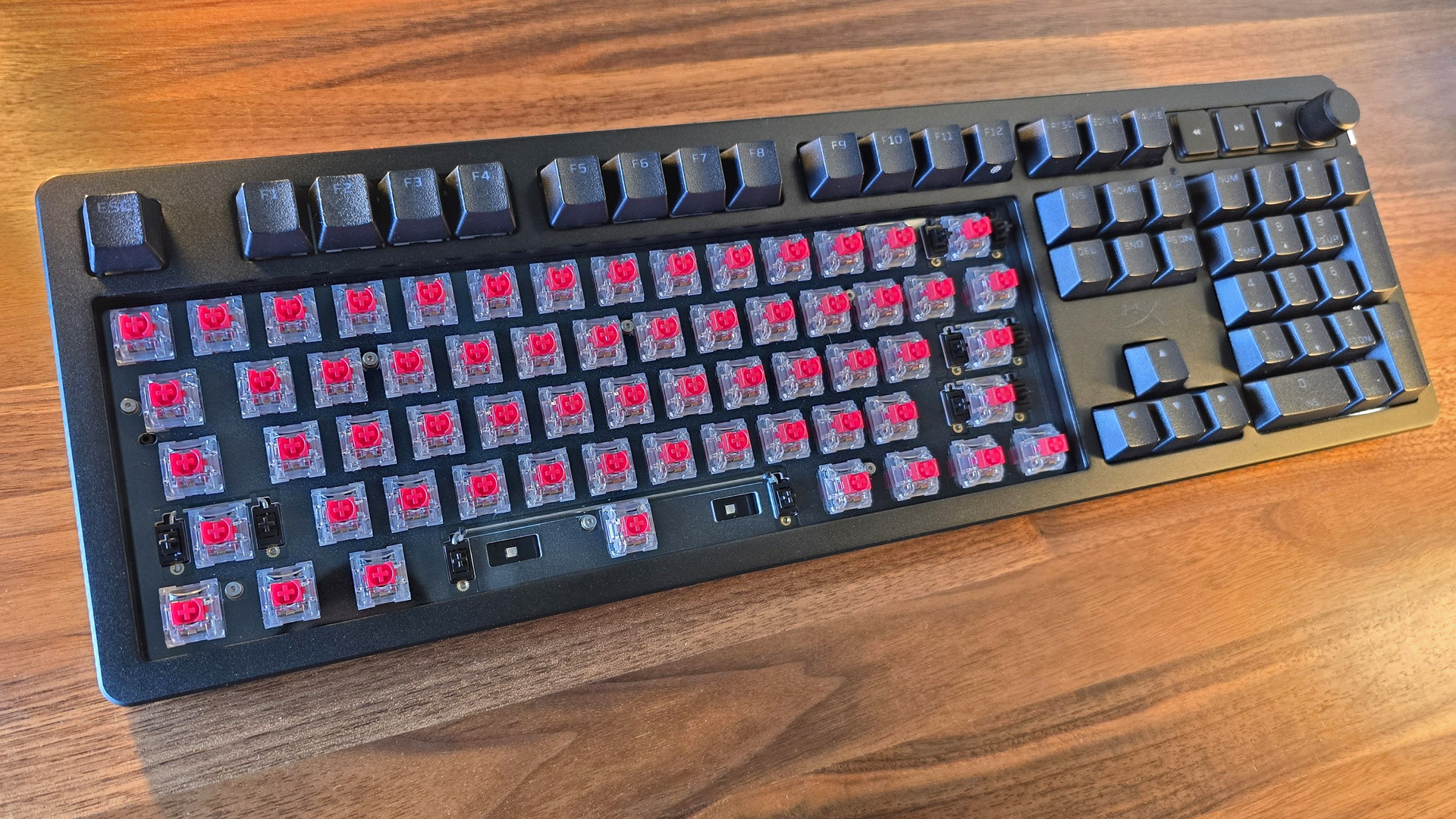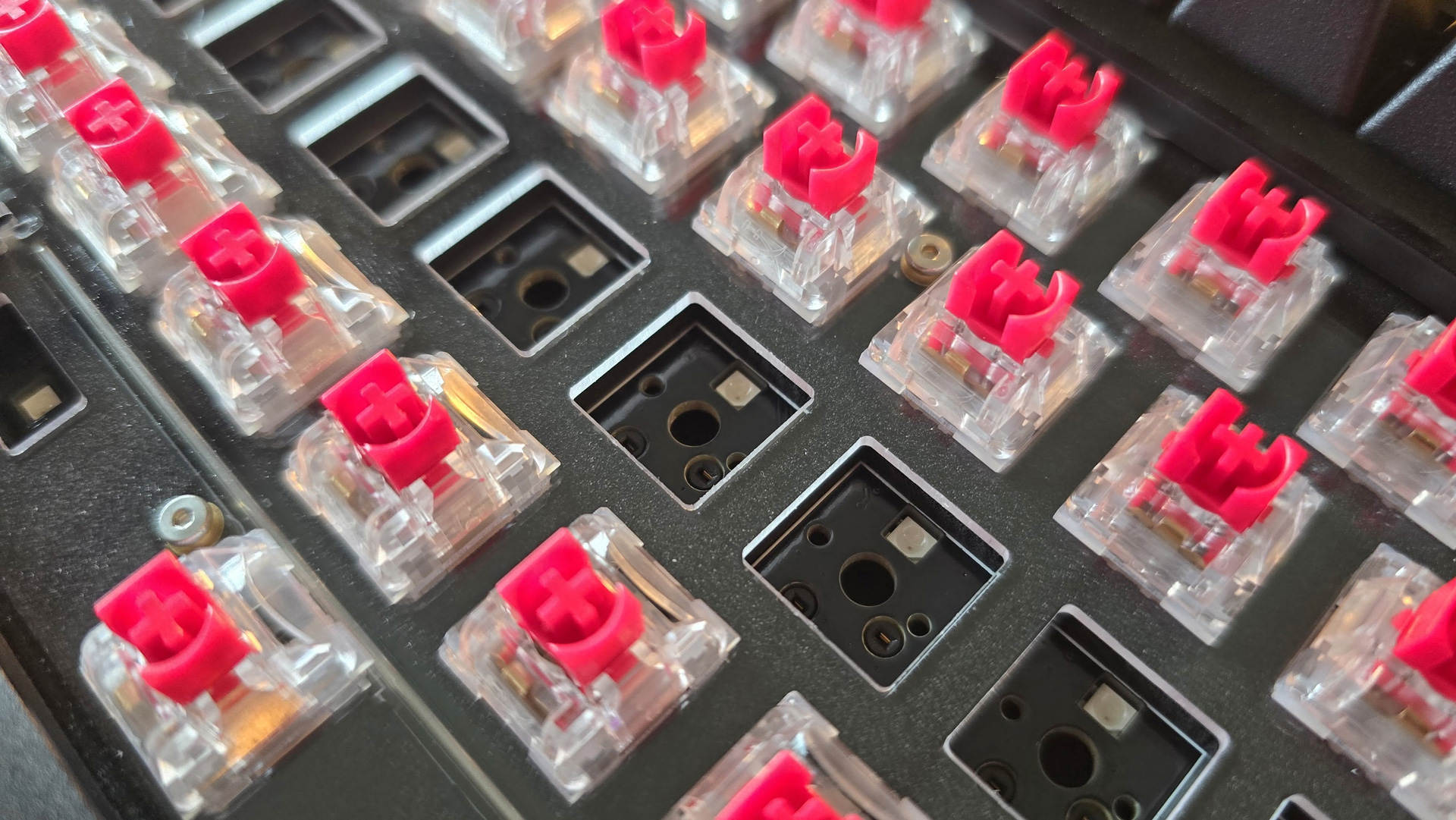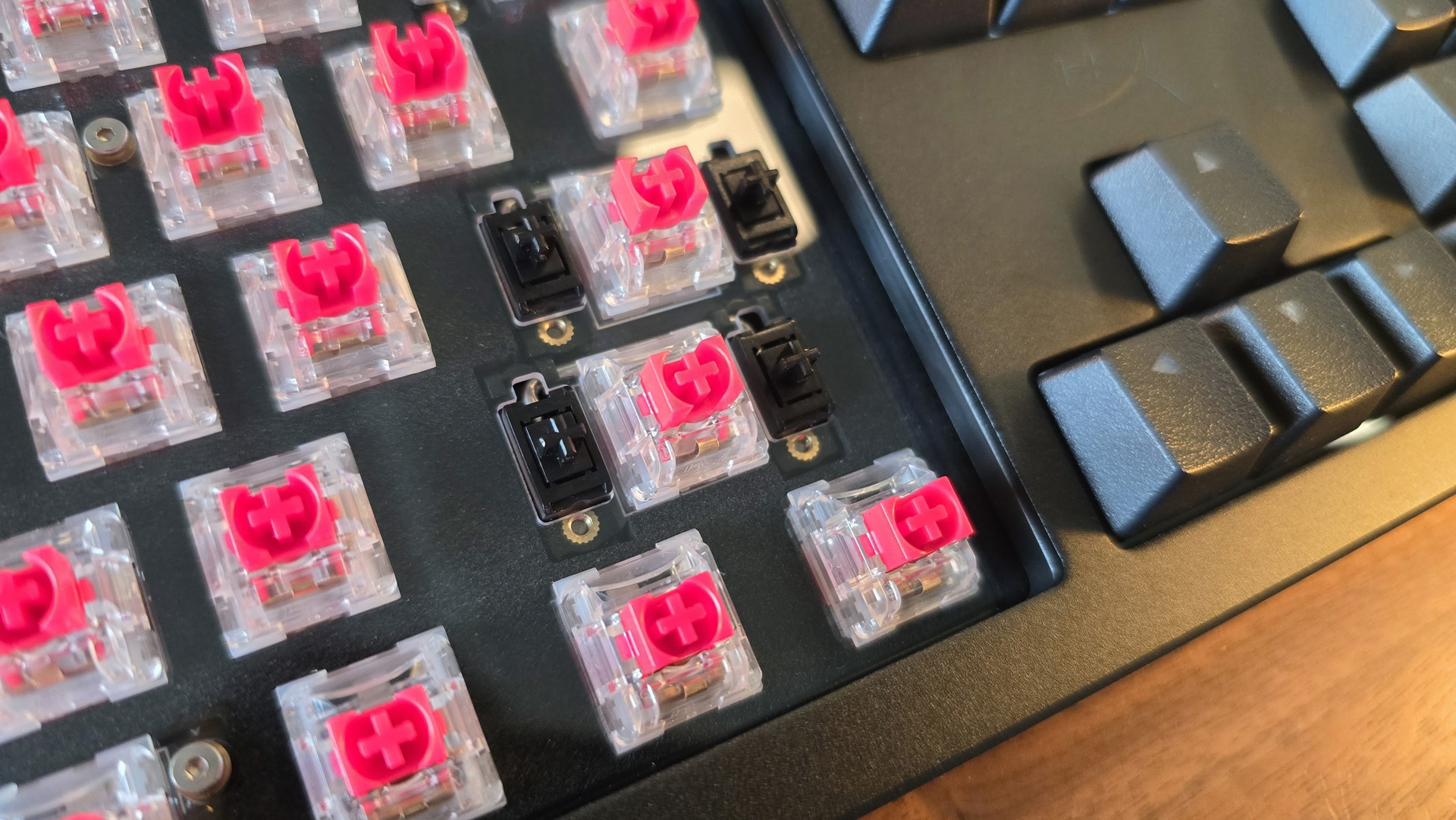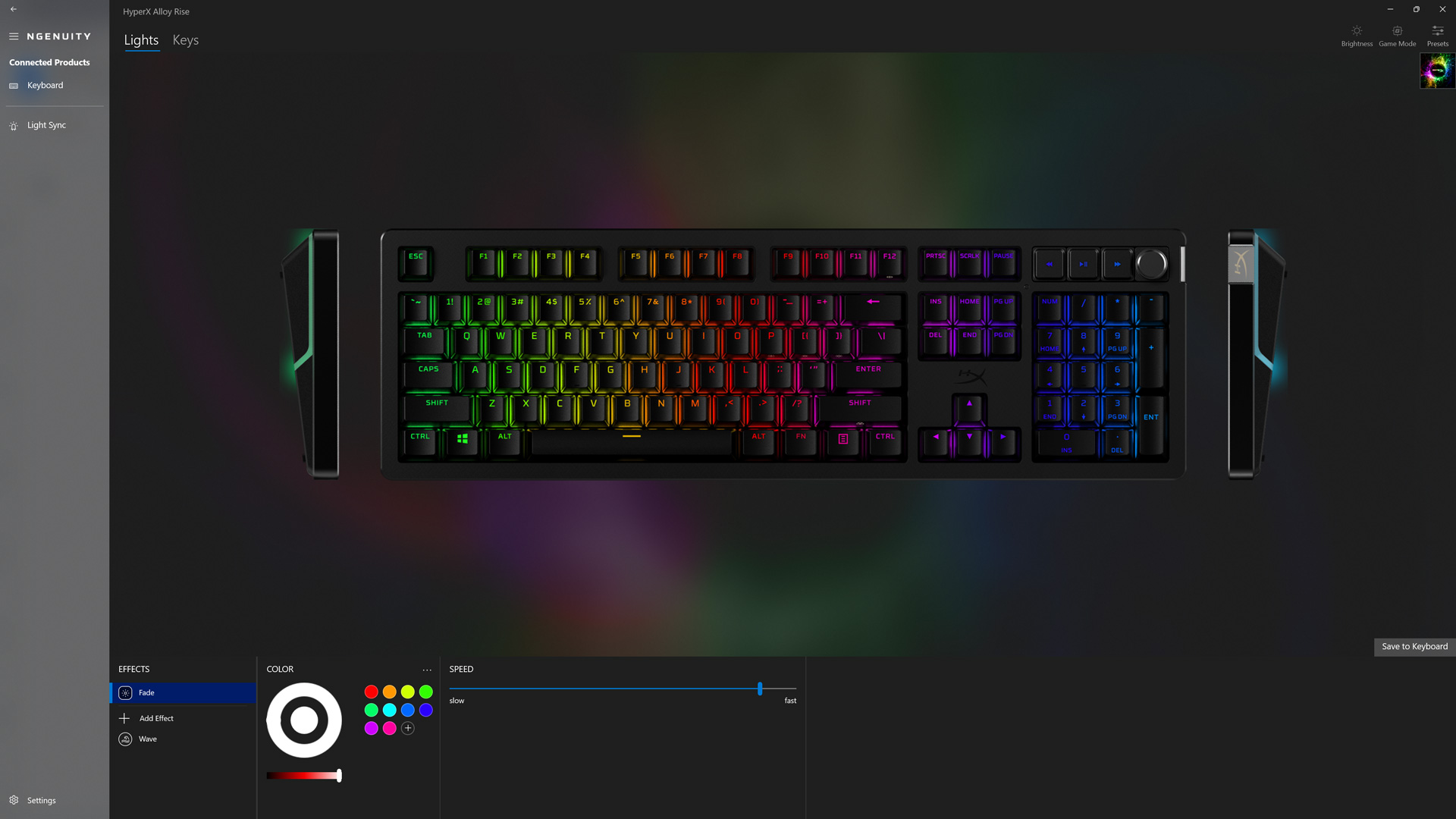Tom's Hardware Verdict
The HyperX Alloy Rise is customizable, well-built, and wired. It’s expensive but with its 8kHz polling rate, fast switches, and easy programmability, it offers solid performance for the money.
Pros
- +
Excellent typing and gaming experience
- +
8kHz polling for exceptional responsiveness
- +
Exceptional customization options
- +
Easy programmability
Cons
- -
Expensive
- -
Not wireless
- -
NGENUITY software is lackluster
Why you can trust Tom's Hardware
The HyperX Alloy Rise takes its cues from the world of custom mechanical keyboards. It’s designed around customization and top-tier typing, offering one of the best typing experiences of any gaming keyboard from a major brand available today. With pre-lubed, hot-swappable switches, swappable top cases and badges, and a soft, gasket mount structure, as well as 8kHz polling and full software programmability, the Alloy Rise splits the distance between gaming and custom keyboards, and is remarkably good overall.
While not quite perfect in fit and function, the Alloy Rise is a prime contender to be one of the best gaming keyboards of the year. Its biggest drawback, however, is its price. At $199.99 for the full-size version and $169.99 for the more compact 75-percent layout, its MSRP undermines its features. It’s good, but when keyboards such as the Drop CSTM80 and the ASUS ROG Strix Scope II 96 exist for less, the Alloy Rise doesn't feel like the best deal.
HyperX Alloy Rise Specs
| Switches | HyperX Linear or Tactile |
| Lighting | Per-key RGB |
| Onboard Storage | 10 profiles |
| Media Keys | Yes |
| Connectivity | USB Type-A |
| Cable | 6 feet, braided |
| Additional Ports | None |
| Keycaps | Doubleshot PBT plastic |
| Software | HyperX NGENUITY software |
| Materials | Aluminum top case, plastic bottom |
| Dimensions (LxWxH) | 17.9 x 5.6 x 1.9 inches |
| Weight | 2.9 pounds |
Design of the HyperX Alloy Rise
At first glance, the HyperX Alloy Rise appears to be a pretty standard full-size gaming keyboard. It has a traditional black chassis that isn’t afraid to throw a rainbow wave at you the moment you plug it in. When you look a little closer — and especially when you type on the Alloy Rise — it quickly becomes apparent that there’s more happening here than meets the eye.
It’s 2024, post- the COVID-19 custom keyboard trend, and pretty much all of the big brands have released enthusiast-grade gaming keyboards that take inspiration from the custom mechanical keyboard community. The Alloy Rise is the latest to jump on this trend and this keyboard embraces customization and quality typing in a way that HyperX’s keyboards have never done before.
Like the Drop CSTM80, the Alloy Rise uses a magnetic alloy top case that can be pulled off and swapped with another without using a single tool. There’s also a swappable metal badge that attaches along the right side. This can also be pulled off or set back in place with a satisfying snap — tool-free.
It’s a neat feature, but as of this writing you can’t really do anything with it just yet. I was sent an alternative top and badge set to try, but the alternatives aren't yet available to purchase. The documentation I was sent says that there should at least be navy and white tops to consider, as well as three different sets of badges (Abstract, 8-Bit, and Cute, sold in sets of four). I do hope they release more in time — as Drop has done — because it’s a neat way to change-up the look of your keyboard.
As you might imagine from a keyboard themed around customization, the Alloy Rise features hot-swappable switches and uses a completely standard layout that lets you easily add your own aftermarket keycaps. The PCB supports both 3-pin and 5-pin switches, so just about any switch or keycap set will work with it.
Get Tom's Hardware's best news and in-depth reviews, straight to your inbox.
At least — if you pick up the full-size version. HyperX is launching this keyboard in both a traditional 104-key layout, as well as a compact 75-percent version for those who prefer mousing space over a dedicated number pad. The 75-percent version takes some liberties with its keys (the Right Shift key is a bit shorter and there’s an extra F13 key to consider), but most aftermarket keycaps sets will still support it.
You may not want to change either, however, because both are very good by gaming keyboard standards. The keycaps are made of double-shot PBT, which is resistant to wear and tear for increased durability. They’re also very thick, which enhances their sound and how solid they feel under your fingers. And, because lighting is a core aspect of customization, they also feature backlit legends that allow the keyboard’s per-key RGB lighting to shine through, bright and consistent, across the entire keyset.
The Alloy Rise comes with your choice of linear or tactile switches. Both options are pre-lubed for smoothness and acoustics and have a faster 1.8mm actuation difference. Is it enough that you can feel the difference? That's debatable, but the difference is there. The switches also have box-style stems to help with wobble, so they’re as stable as they are smooth.
The construction of the keyboard is layered — literally. The swappable top cases are made of metal but the bottom, including its single-stage tilt feet, are plastic. Internally, it uses a plastic switch mounting plate on top of a layer of foam for soft bottom-outs. I didn’t disassemble this keyboard (there are enough screws where it seems clear that you’re not intended to), but I suspect there’s an additional layer of foam or silicone in the bottom of the case, too.
The combined effect of these foams is to remove any errant vibration or hollowness from the case, isolating the sound of the switches. This makes the keyboard sound more crisp, clean, and quiet. The Alloy Rise is arguably volume-matched to a typical membrane keyboard, which is pretty impressive for a mechanical set of keys.
The circuit board and plate assembly rests on flexible gaskets surrounding the keys. This gasket mount structure isolates keystrokes and provides a cushion for each press. Full-size gasket mounted keyboards aren’t common and those that exist tend to offer minimal reaction when typing normally — but that’s definitely not the case here. Looking closely, you can see that each key gives, subtly, under normal typing pressure, making it easy to type on without experiencing the early fatigue — typical of most gaming keyboards — from slamming against a rigid structure.
On the gaming front, HyperX has designed the keyboard to be exceptionally responsive. In addition to its smooth, faster-actuating switches, the Alloy Rise also features an 8,000Hz polling rate. The majority of gaming keyboards operate at 1,000Hz, which means they report key presses to the computer every millisecond (1ms response time). This keyboard reports key presses eight times more frequently, or every 0.125 milliseconds. Beyond 1ms, we're into the range of “you need to be a machine to tell the difference.” But if you’re a competitive player, it makes sense to get the highest performance peripheral you can afford — there's no blaming the keyboard for a delay with the Alloy Rise, which is as fast as it gets currently.
Apart from its gaming prowess, the Alloy Rise also features an ambient light sensor that automatically adjusts the backlight brightness to match the lighting in your environment. In a bright setting, it will ramp it up, and in a dark setting it will decrease the brightness so as not to distract you.
The keyboard's braided cable is also detachable, so you can swap it out with one of your own. HyperX is happy to sell you (separately, of course) an eye-catching coiled aviator cable to impress all of your fellow keyboard enthusiast friends.
The Alloy Rise's onboard controls are surprisingly limited. There’s a click-to-mute volume knob and three media keys for controlling tracks, but there’s no way to cycle lighting effects unless you tie a different preset to each of its ten profiles. Instead, you can adjust brightness, enable or disable the ambient light sensor, turn on game mode, and swap profiles. You can add more Fn commands using the software — but, out of the box, that's it.
For $200, I really expected this keyboard to be wireless. The ASUS Strix Scope II 96 Wireless offers a similar typing experience, better programmability, and both 2.4GHz wireless and Bluetooth connectivity for $180. The Alloy Rise is unmistakably great to use, but it really feels like you're paying a premium for the swappable cases (which the Drop CSTM80 has for $130) and 8K polling (which you likely won't even notice).
The typing experience of the HyperX Alloy Rise is outstanding. It is genuinely one of the best-feeling gaming keyboards I have used all year, and it easily ranks among the best currently on the market — including high-water marks such as the ASUS ROG Azoth, Strix Scope II 96, Corsair K65 Plus Wireless, and the Razer Blackwidow Pro V4 75.
HyperX clearly paid attention to what keyboard enthusiasts have been clamoring about over the last several years. The Alloy Rise is designed to deliver a typing experience that makes you want to come back to your computer for another round — or, as is usually the case with me, an extra page of writing.
The Alloy Rise's impressive typing experience starts with the keycaps, which are an impressive 1.5mm thick and have a solid, deep sound when bottomed out. They’re also textured to provide a bit of extra grip and they feel nice under the fingertips.
Next up are the switches, which are very good. I was able to test both the linear and tactile switches and both are pre-lubed and are noticeably smoother than their Cherry MX Red and Brown counterparts. There’s no spring noise to speak of when typing, so all you hear are crisp, full-bodied keystrokes. As a bonus, they let enough light through the legends that you can easily type in the dark, even if you’re not a touch typist.
The gasket mounting structure is the best implemented of any “big brand” gaming keyboard I’ve seen. It’s right up there with Keychron Q-series in how reactive it is to normal keystrokes. There’s noticeable movement when typing normally (which isn’t always the case), but it isn't so noticeable as to be distracting. Rather, the keystrokes are soft and responsive.
HyperX also did a great job with the stabilizers. They’re not the least bit rattly and are very stable. Though I didn’t disassemble the keyboard, it’s clear that the company took the time and applied a consistent coat of lubricant on the wires beneath the larger keys to make them sound as good as they do.
Needless to say, I really enjoyed typing on the Alloy Rise. Between its solid build, thick keycaps, and smooth switches, it definitely achieves the same middle ground between gaming and enthusiast keyboards as its competitors. While I wouldn’t say the experience is “better” than the others, due to how subjective that term is at this level, it’s certainly on par with them — and it isn’t likely to disappoint with the quality of its keys.
During my time with the Alloy Rise, I played a heaping helping of Baldur’s Gate 3, but also dipped my toes into Battlefield 2042’s latest season, Call of Duty: Modern Warfare 3, and the classic, World of Warcraft. In every circumstance, the Alloy Rise rose to the occasion and carried me through.
I’ll tell you right now: I’m not a pro gamer, but I do enjoy competitive first-person shooters. I play games on a 240Hz monitor and I am sensitive to input lag and delay. There’s not an ounce of sluggishness in this keyboard. It transmits inputs instantaneously. When it came to running around the alleyways in COD’s Favela map or peeking from cover and rushing the flag on Battlefield 2042’s Exposure, I would put this keyboard up against any magnetic or optical gaming slate.
Much of the reason it feels so good to play games on the Alloy Rise is thanks to its switches. HyperX’s linear switches are a hair lighter and faster to actuate than Cherry MX Reds, which adds to their responsive feeling. The pre-lubing makes it easy to prime yourself for movement and — in my opinion, just as importantly — allows you to forget about the feeling of the switches in the moment and focus on your play. The lack of telltale Cherry scratchiness makes them feel more fluid when pressed.
The full-size layout isn’t the best for gamers that enjoy big mouse sweeps. The additional space to accommodate the number pad forces you to space your hands out more and leaves less room for mousing. If you’re a sweep-styled player but you like everything else about this keyboard, I recommend going for the 75-percent version to enjoy the best of both worlds.
For MMOs, the number pad comes in handy as a macro pad. With NGENUITY (or even WoW’s in-game settings), I was able to map all of my skills and abilities to it. For my additional action bars, I tied those skills to modifier keys and the numbers (Shift+1, Shift+2, and so on). If you’re playing anything where you need extra remappable keys, the numpad comes in clutch.
The Rise uses HyperX’s NGENUITY software for all of its customization options. As of this writing, this includes being able to remap most of the keys, assign macros, Windows shortcuts, multimedia functions, and mouse controls. The lighting for each key is also programmable and can be assigned in layers to create a wide array of custom effects and animations.
While the software gets the job done and is decently polished, it feels very barebones. There are only two tabs — Lighting and Keys, and three toggles in the upper right that control brightness, enable game mode, and to choose one of your previously made presets. The NGENUITY software is sparse, but it's also pretty lightweight; it took up only about 210MB of my system’s memory.
NGENUITY gets the job done quickly for most things you would want to do. Changing a keymap is done by clicking the key you would like to change and then choosing what type of assignment you would like (Keyboard, Mouse, Macro, etc.). From there, you simply choose the option or press the key you would like mapped to that position. If you’d like to assign a macro (and you haven’t already recorded it) the Macro menu gives you an option to record a new one on the spot — it’s streamlined and straightforward.
The software allows you to map functions to either the Base or Fn layer. The former replaces the normal key matching the keycap. The Fn layer allows you to map actions as secondary functions, whenever that key is held. You can’t overwrite the built-in commands, but most keys are still free. My biggest gripe is that you can’t remap the Fn to another location. Versions of this functionality have been available in gaming keyboards for years (Razer’s HyperShift, for example), and it allows you to free up how you access different commands to a way that works for you.
Programming the Alloy Rise's RGB lighting is straightforward and intuitive. There are 11 lighting effects (12, if you count static colors) that can be assigned to the whole keyboard or to individual keys. The effects can also be layered — so you can have a background effect, such as a rainbow wave, and also set each key’s lighting to respond when pressed.
NGENUITY was mostly stable and it didn’t outright crash on me but it did break at least once. After recording, then canceling a macro, it stopped registering inputs at all inside the recording window. Only restarting the program made it work correctly again.
I was also surprised that there was no option to configure the Alloy Rise's polling rate. 8,000Hz is intensive and can eat CPU resources, so it’s common for manufacturers to provide an option to set it back to 1,000Hz. I didn’t notice any performance strain on my system, but I also have a high-powered rig. Without any way to lower its connection speed, gamers with older processors may want to think twice about picking the Rise up.
Bottom Line
The HyperX Alloy Rise is an excellent gaming keyboard that feels great to use and performs just as well in games. Its pre-lubed switches and well-implemented gasket mount structure make it smooth, soft, and reasonably quiet for use in an office or with roommates. It’s easy to customize, whether you want to pop on an alternate top case or side badge, or swap in your own switches, keycaps, or detachable cable. The Alloy Rise is designed to be made your own.
But for all of its strengths, the asking price just feels too high. The keyboard's hallmark feature — the swappable case — is already readily available on the Drop CSTM80, which is a fantastic keyboard and is much cheaper. And the ASUS ROG Strix Scope II 96 goes toe-to-toe with the Alloy Rise when it comes to sound, feel, and gaming functionality, while also saving desk space and offering excellent wireless performance for $20 less.
What it comes down to is how much you value having that top case be metal (most of the CSTM80’s are plastic), and how important 8K polling is to you. If you don’t mind playing wired and you want a keyboard that feels as premium as its price, lets you customize its aesthetic, and puts a premium on speed, the HyperX Alloy Rise is absolutely worth considering. For everyone else, it's safe to consider the alternatives while you wait for a sale.
MORE: Best Gaming Keyboards
MORE: How to Pick Keycaps for Your Mechanical Keyboard
MORE: How to Build a Custom Mechanical Keyboard

Chris is a regular contributor for Tom’s Hardware, covering mechanical keyboards, peripherals, and content creation gear.
-
Sleepy_Hollowed I've found the "wired" con on a lot of keyboards, if not all, to be insane.Reply
Unlike mice, where it's an actual minus to not be wireless (on most cases), you really don't want to have a wireless keyboard unless you do all things with the keyboard that do not require entering a password.
That's almost no one I would like to think, unless you're in the minority that has set up yubikeys to sign in to your Operating System.
All that out of the way, this is an interesting keyboard that I would not have guessed HyperX was still all in on mechanical keyboards, given all the competition out there. -
Leptir I agree, wireless keyboards are a security risk for most people. In fact, every time I look outside, there's a spook right under my window holding an antenna and ready to snoop on my wireless keyboard.Reply
SMH -
DonQuixoteIII I game, but do not think I am a 'gamer'. My current keyboard is a Steelseries Apex Pro, which I very much like for its switches and their adjustability. How I would love for this keyboard to go with swappable keys....Reply
As to the 'wireless' debate... I really, really dislike batteries. -
Sleepy_Hollowed Reply
I'd be more worried about kids.Leptir said:I agree, wireless keyboards are a security risk for most people. In fact, every time I look outside, there's a spook right under my window holding an antenna and ready to snoop on my wireless keyboard.
SMH
It's really not that hard to get that data anymore, it's not 1999.
Tell me you've never typed your credit card info.
Teenagers these days are something.

